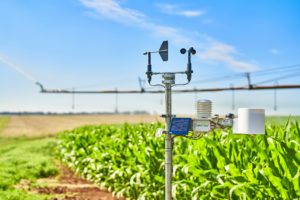The climate and local weather conditions have a key influence upon agriculture. Weather events such as heat, drought, heavy rain or frost have always governed the everyday life of farmers. Accelerating climate change is making extreme weather events more common. But the latest technologies can help to predict and respond to them.

The quality of crops and the reliability of yields are strongly linked to the prevailing weather. Since land is generally cultivated in the form of open fields, the predominant climatic conditions determine which types of crops can be cultivated. Influencing these climatic conditions is, however, virtually impossible.
Irrigation can compensate for a lack of precipitation and excess rain can be diverted by drainage. However, it is not only the total annual moisture but, above all, its distribution over time that is decisive for optimal growth. There are very sophisticated technical means of optimising this distribution. For example; moisture sensors placed in the soil at various depths measure the daily water consumption of plants in the different layers of soil. The optimal time for irrigation is then calculated by software. This helps to avoid the stress caused by both drought and excessive watering. The advantages of using such soil probes include potential reductions in the need for irrigation and fertiliser and, hence, in the environmental impact of a crop.
In addition to precipitation, the key agricultural factors for successful crop production include soil temperature and soil moisture. The interaction between soil temperature and the number of daylight hours impacts upon both the vitality and development rate of crops. When the soil temperature drops below 0° C, water in the soil begins to freeze. This can hinder the uptake of liquid fertilizer, while frost can cause roots to crack. Other important factors include global radiation, light intensity, air humidity and wind speeds.
Data collection
There is probably no industry that is as closely linked to the weather as agriculture. This means that precise weather data are particularly important. In addition to the many parameters that describe meteorological events in the atmosphere, certain measured and observed variables are particularly relevant in the agricultural context. These data are collected by weather stations and can be displayed in real time via platforms or apps. Automatic notifications (e.g. frost warnings) via SMS are now standard.
The latest weather stations can include a wealth of different sensors and can easily be customised to meet individual needs. Air temperature, global radiation, rainfall, wind speed and leaf wetness, etc. are just a few of the many agricultural and other environmental parameters that can be measured, logged and sent to a platform. Many manufacturers of weather stations offer additional services based on these values. Localised weather forecasts for a very limited area can thus be produced, and calculations of plant disease models can also be offered. It is also possible to automate irrigation systems and to combine these with precise data monitoring.
Data interpretation
Current and historical weather data are essential if we are to understand the factors that could negatively impact upon crops, while future weather data and forecasts are especially important for planning field operations and future practices. The role of forecasts – for periods ranging from the next few minutes to the next few hours – is to capture and accurately predict events such as localised heavy rain, hail or gusts associated with thunderstorms. Local real-time measurements from the weather station are used to subsequently correct the modelled forecast. The result is that farmers receive a weather forecast that is tailored to their fields and can better plan or even, in the event of imminent showers or excessive wind, postpone work.
Another area of application is the forecasting of diseases in order to allow farmers to use plant protection products more efficiently. The consolidation of data collected in the field allows predictions to be made regarding the likely occurrence of plant diseases and pests, with diseases being predicted on the basis of calculation and pests detected with the help of semi-automatic traps. More specifically, optical high-resolution camera systems can be used together with Artificial Intelligence (AI) software to detect insects. Such remote monitoring of insect pressure saves time and allows targeted and sustainable action to be taken.
Every crop needs water, but it is crucial to know exactly when. As mentioned above, soil moisture sensors distributed at different soil depths in different parts of a field can help to provide this information by offering an excellent overview of a plant’s daily water consumption in different soil layers. Software designed for this purpose can subsequently help to calculate the best irrigation time or immediately incorporate this information into the irrigation management process.
Data transmission
Since fields generally have neither a power supply nor a data transmission infrastructure, weather stations are designed to function self-sufficiently for several years. The power supply is usually provided by a rechargeable battery and solar panel. Depending upon the scale of the network and the volume of data, a range of radio technologies come into question. These are, firstly, the SIM-dependent radio technologies provided by mobile network operators such as NB-IoT and LTE-M and, secondly, transmission technologies like Sigfox and LoRa. These transmission technologies ensure lower costs, low power consumption and long ranges.
Outlook
Digitalisation has long since arrived in agriculture. The collection of data in the field is a small but enormously important part of this phenomenon. Farmers increasingly rely upon networked machines and smart devices to make their daily work easier. Digitalisation enables them to optimise operating processes with the help of innovative solutions and, thus, to work more cost-efficiently, sustainably and in a more environmentally friendly manner.
Photo (c) Pessl Instruments
